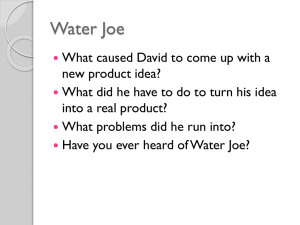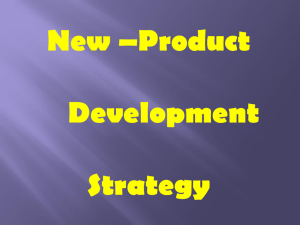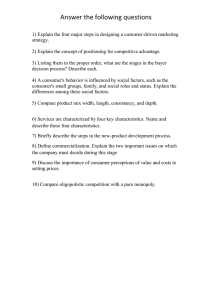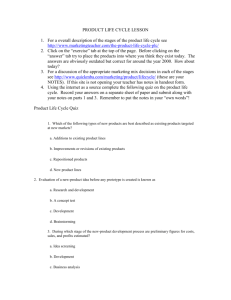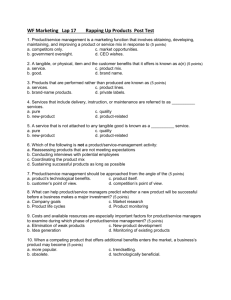Process Development & Innovation Management Presentation
advertisement
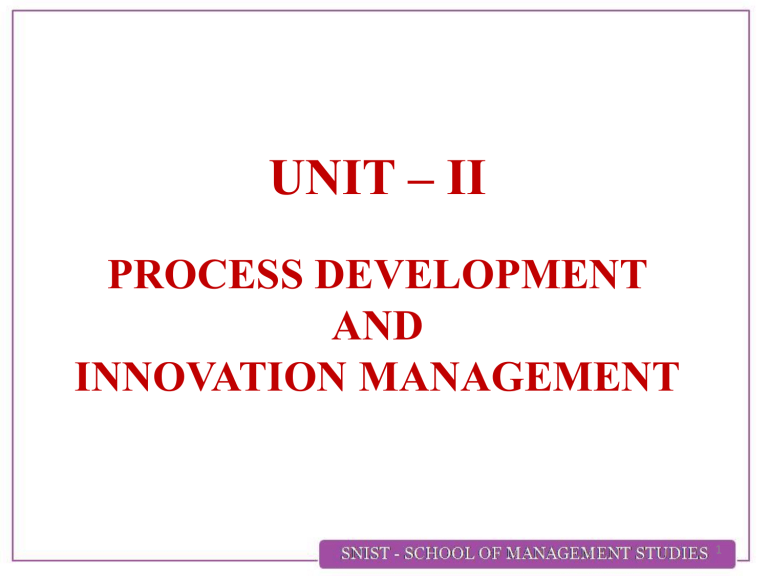
UNIT – II PROCESS DEVELOPMENT AND INNOVATION MANAGEMENT 1 Process Business Modeling BUSINESS PROCESS MODELING 2 What is Business Process Modeling? Business process modelling is a means of representing the steps, participants and decision logic in business processes. It is the analytical representation or illustration of a organisation’s business processes There are three main types of process models: 1. Descriptive models: Written explanations of the processes 2. Active models: A working model that represents the processes (eg. computer simulations) 3. Diagrammatical models: A diagram that shows the processes and the relationships between them (eg. process maps and flowcharts.) 3 Why Business Process Modeling? Need for BPM a. To engineer/ develop business system b. To establish business activities logically c. To keep business process technologically updated d. To analyse and improve current business process e. To attain the expected operational quality f. To reduce modifications and wastage g. To develop process efficiency and productivity 4 Process mapping at a Distribution Center Dealer Faxes Order Paper Order Created 4% of orders lost Order Sits In Fax In Box 0 to 4 hours 2 hours on average Order Sits In Clerk’s In Box Internal Mail Delivers Fax 0.5 to 1.5 hours 1 hour on average 1% of orders lost 0 to 2 hours 1 hour on average Clerk Processes Order 5 minutes 10 to 45 minutes 20 minutes on average Dealer Receives Order Transport Firm Delivers Order 1 to 3 hours 2 hours on average No history of lost, damaged, or incorrect deliveries Inspector Checks Order Worker Picks Order 2 minutes 0.5% of orders incorrect YES Is Item In Stock? NO Clerk Notifies Dealer and Passes Order On to Plant 5 Improving Business Processes: Guidelines • Attack each delay – What causes it? – How long is it? – How could we reduce its impact? • Examine each decision point – Is this a real decision or just a checking activity? – If the latter, can we automate or eliminate it? • Dematerialize documentation. – Can we do it electronically? – Eliminate multiple copies? – Share a common database? 6 What Measures Business Process? Business Process Measures Productivity : Measuring the relationship or ratio between inputs incorporated for a particular out Efficiency : A comparison of a company’s actual performance to some standard Cycle Time : Total time required to complete a process from start to finish. Bench Marking : A comparison of a company’s performance to the performance of: Other firms in its industry (strategic), Firms identified as “world-class” (process) 7 Business Process Modeling Techniques • Business Process Modeling and Notation [BPMN] • Cognition enhanced Natural Languages Information Analysis Method [CogNIAM] • Extended Business Modeling Language [xBML] • Event-driven Process Chain [EPC] • ICAM DEFinition [IDEFO] • United Modeling Language [UML] 8 Value Chain Analysis for Manufacturing and Services Industries 9 Michael Porter’s Value-Chain • Developed in 1985 by Michael E. Porter in Competitive Advantage • Highlights cost advantages and distinctive capabilities--the value processes • Value chain refers to the process or activities by which a company adds value to an article, including production, marketing, and the provision of after-sales service. 10 Value Chain and the QCT Triangle • VC allows alignment of processes with customers. This generates a quality advantage. • VC focuses cost management efforts. • VC provides for efficient processes which improves the timeliness of operations. • Value Chain Benefits • Identifies value processes • Identifies areas for cost improvement 11 QCT Triangle • Time: Completion of tasks depends on a number of factors such as the number of people working on the project, experience, skills, etc. Time is a crucial factor which is uncontrollable. • Cost: Budgets will ensure that project is developed or implemented below a certain cost. • Quality: Many project managers are under the notion that 'high quality comes with high cost', which to some extent is true. 12 Value Chain for Manufacturing Industries from Michael E. Porter’s Competitive Advantage 13 Value Chain for Manufacturing Industries from Michael E. Porter’s Competitive Advantage • There are (5) primary activities. Inbound Logistics: Receiving, inventory, and distribution of inputs from suppliers. Operations: Transforming inputs into a final product. Outbound Logistics: Moving the final products and services to customers. Marketing & Sales: Communicating product's to customers and then selling products. Service: Providing customer service and maintaining the value of a product. 14 Value Chain for Manufacturing Industries from Michael E. Porter’s Competitive Advantage • There are (4) support activities. Firm Infrastructure: Legal, administrative, accounting, and management Human Resource Management: The ability for a company to hire, train, motivate, and reward employees. Technology Development: Research & design and information systems are able to generate value which in turn can create a competitive advantage. Procurement: Sourcing raw materials and negotiating contracts can definitely add value to a company. 15 Profitability and Revenue Growth Customer Loyalty Internal Service Quality Employee Satisfaction Value Chain for Service Industry Employee Productivity Customer Satisfaction External Service Value Employee Retention 16 Value Chain Elements • Customer value added • Margin orientation • Primary activities – – – – – Inbound logistics Operations Outbound logistics Sales and marketing Service and support • Support Activities – Human resources (general and admin.) – Tech. development – Procurement 17 Goal of Value Chain • Driven by customer perceptions • Increase margins • Focus on value processes – Distinctive capabilities – Cost advantages • Some examples – Southwest Airlines – Intel Corporation 18 Value Chain Analysis • Document the activities • Understand the cost and margins at each step. – Use Activity Based Costing • Map the value chain to the industry value chain – Look for core competencies • Map the cost structure – Note that external values drive cost advantages 19 Discovering Your Own Value Processes • Distribute a summary of the value chain model. • Create functional process lists. • Transfer lists to color-coded labels. • “Pin the process” on a large VC diagram. • Identify appropriate processes as: – Cost advantage – Core competency 20 Using the Value Chain • • • • Helps you to stay out of the “No Profit Zone” Presents opportunities for integration Aligns spending with value processes Provides for reconfiguration of the value chain – – – – outsourcing off-shoring co-location with customers or suppliers redesign for efficiency • Involves chain partners: customers & suppliers 21 22 Frugal Innovation • Design to extreme affordability • Strategic thinking towards volume markets • Creativity and innovation towards extreme affordability • Design, engineer and produce for marginal markets • Translating and innovating a high margin brand for low margin markets • Creating and innovating towards branded and quality products for marginal markets 23 Frugal Innovation Market Potential Source : WRI 2008 24 25 26 Electric Tricycle 27 Example :Service Sector-Microfinance • Microfinance is the offer of financial & non-financial services to people excluded from the traditional banking system. The services are adapted to the needs of the target populations. MICRO • Micro-entrepreneurs • Self-employed • Low income populations • Excluded populations FINANCE • Business & educational loans • Savings • Micro-insurances • Remittances • Micro-entrepreneur training • Coaching & workshops on health, hygiene, etc. 28 Fast Moving Consumer Goods • • • • • • • • Sampoo Bathing Soaps Beauty Items Utensils Coolers and ACs Refrigerators TV sets Washing Machine 29 Hot Water Maker 30 Prefabricated Houses 31 Theoretical Perspective www.frugal-innovation.com 32 Creative Process in Developing Innovation 33 Creativity, Innovation and Entrepreneurs Creativity is thinking new things, and innovation is doing new things Creativity is the ability to develop new ideas and to discover new ways of looking at problems and opportunities. Innovation is the ability to apply creative solutions to those problems and opportunities in order to enhance people’s lives or to enrich society Entrepreneurship = Creativity + Innovation 34 Definition of Creativity “Creativity is any act, idea, or product that changes an existing domain, or that transforms an existing domain into a new one… What counts is whether the novelty he or she produces is accepted for inclusion in the domain.” “Creativity is nothing more than seeing and acting on new relationships, thereby bringing them to life.” “Creativity is defined as the act of turning new and imaginative ideas into reality. Creativity involves two processes: thinking, then producing. Innovation is the production and implementation of an idea. If you have ideas, but don’t act on them, you are imaginative but not creative.” 35 Creative Thinking Process 1. 2. 3. 4. 5. 6. 7. Preparation Saturation Deliberation Incubation Illumination Verification Accommodation 36 STAGES OF THE UNIVERSAL CREATIVE PROCESS Clarify situation Generate ideas Develop solutions Implement action 37 Creative Thinking Techniques 1. 2. 3. 4. 5. 6. 7. 8. Attribute Listing Check List Method Morphological Analysis Brainstorming Synectics Thinking Hat Method Nominal Group Technique Fishbone Diagram 38 Creative Thinking Techniques 39 Brainstorming Brainstorming • Brainstorming is a method for generating ideas to solve a design problem. • It usually involves a group, under the direction of a facilitator. • The strength of brainstorming is the potential participants have in drawing associations between their ideas in a freethinking environment, thereby broadening the solution space. Morphological Analysis • • • • Define the problem Define the problem in a short and clear statement. Identify attributes and values List the things about the situation that can be varied or changed in some way. Select a subset of two to six variables to investigate further. Combing items • Find a way of combining items from the lists you have created. Synectics • The term "synectics" is derived from the Greek word "synectikos," which means to bring different things into unified connection. • Synectics is an approach to problem-solving that focuses on cultivating creative thinking, often among small groups of individuals with diverse experience and skills. Synectics Morphological Analysis - Example 45 Attribute Listing Thinking Hats Method Fish Bone Diagram Fish Bone Diagram Nominal Group Technique Nominal Group Technique The following questions are designed to stimulate the imagination and can help develop creativity: 1. Is there a new way to do it? 2. Can you borrow or adapt it? 3. Can you give it a new twist? 4. Do you merely need more of the same? 5. Do you just need less of the same? 6. Is there a substitute? 7. Can the parts be rearranged? 8. What if we do just the opposite? 9. Can ideas be combined? 10. Can we put it to other uses? 11. What else could we make from this? 12. Are there other markets for it? 52 New Challenge • A company manufactures glassware. • The last step of the process is to wrap glasses individually in used newspapers and then place them in a specially designed box. • The box is then sealed. Management notices low productivity with this last step, observing that workers occasionally stop to read the newspapers? What can management do to increase productivity? 53 Types, Forecasting and Stages New Product Development 54 Meaning of New Product Development •Product development means making changes in the size, design, color, shape, characteristics, packing etc. of the product. •It may include addition of a new product line, addition of a new product item in a particular product line, elimination of existing product or product line & changes in the size, color, design, packing, characteristics, and prices of the product & discontinuation of the unprofitable item or product line. 55 Definition • New product development (NPD) is the complete process of bringing a new product to the market till its consumption & feedback from the end user of the business chain through the systematic procedure & parameter. • It may be a consumable product, service or idea. 56 New Product Categories • • • • New to the world products New product lines Product line extensions Improvements and revisions to existing products • Repositionings • Cost reductions 57 Why New Products? • New product development is essential to any business that must keep up with market trends and changes. • Approximately one-third of the revenue a business generates is coming from products they did not sell five years ago • Changing environment creates new demands and needs 58 Industrial New Product Ideas • • • • • • • Company sources other than R&D Analysis of the competition Research & Development Product users Supplier suggestions Product user research Published information 36.2% 27.0% 24.3% 15.8% 12.5% 10.5% 7.9% 59 New Products necessity • A way of getting new and keeping old customers • Effective way of obtaining a competitive advantage • Source of growth and excitement 60 What is Forecasting? Process of predicting a future event ?? Underlying basis of all business decisions • • • • Production/ Product Inventory Personnel Facilities 61 New Product Forecasting Issues Low accuracy (high forecast error) Low credibility Limited amount of data available for analysis Inability to fully capture market complexity, cannibalization, market penetration rate, etc. Limited amount of time for analysis 62 Keys To New Product Forecasting There is no silver bullet when it comes to new product forecasting. New product forecasting success is a result of data, experience, cross-functional communication, business knowledge, and being connected to the customer. Use a toolbox approach when applying new product forecasting techniques. New product forecasting requires reconciliation of multiple techniques based on judgment and analytical skills. New product forecasting is a process of managing assumptions. Think in terms of ranges, not specific numbers. 63 Forecasting Techniques Jury of executive opinion • Pool opinions of high-level experts, sometimes augment by statistical models) Delphi method • Panel of experts, queried iteratively until consensus is reached Sales force composite • Estimates from individual salespersons are reviewed and then aggregated Consumer Market Survey • Ask the customer 64 New-Product Development Process 65 New-Product Development Process New idea generation is the systematic search for new product ideas. Sources of new-product ideas: Internal sources External sources • Refers to the company’s own formal research and development, management and staff, and intrapreneurial programs. • Refer to sources outside the company such as customers, competitors, distributors, suppliers, and outside design firms. 9-9 66 New-Product Development Process Idea Screening: Refers to reviewing newproduct ideas in order to drop poor ones as soon as possible. 9-10 67 New-Product Development Process Concept Development and Testing: Refers to newproduct concepts with groups of target consumers. Product idea • An idea for a possible product that the company can see itself offering to the market Product concept • A detailed version of the idea stated in meaningful consumer terms. Product image • The way consumers perceive an actual or potential product 9-11 68 New-Product Development Process Marketing Strategy Development: Refers to the initial marketing strategy for introducing the product to the market. Marketing strategy statement • Description of the target market • Product positioning, sales, market Part 1: share, and profit goals Part 2: • Price, distribution, and budget • Long-term sales, profit goals, and Part 3: marketing mix strategy 9-13 69 New-Product Development Process Marketing Strategy Development When firms test market? • New product is introduced with large investment. • Uncertainty about product or marketing program When firms may not test market? • • • • Simple line extension Copy of competitor product Low costs Management Confidence 9-18 70 New-Product Development Process Marketing Strategy Development Business Analysis • Involves a review of the sales, costs, and profit projections to find out whether they satisfy the company’s objectives. Product Development • Involves the creation and testing of one or more physical versions by the R&D or engineering departments. Requires an increase in investment Test Marketing • Test marketing provides the marketer with experience in testing the product and entire marketing program before full introduction 9-15 71 New-Product Development Process Approaches to test marketing: Standard test markets Controlled test markets Simulated test markets 9-19 72 New-Product Development Process Marketing Strategy Development Standard test markets Are small representative markets where the firm conducts a full marketing campaign. Makes use of store audits, consumer and distributor surveys, and other measures to gauge product performance. Results are used to forecast national sales and profits, discover product problems, and fine-tune the marketing program. 9-20 73 New-Product Development Process Challenges of standard test markets: Cost Time Competitors can monitor the test Competitor interference Competitors gain access to the new product before introduction 9-21 74 New-Product Development Process Marketing Strategy Development Challenges of standard test markets • Cost • Time • Competitors can monitor the test • Competitor interference • Competitors gain access to the new product before introduction 9-21 75 New-Product Development Process Marketing Strategy Development Controlled test markets are panels of stores that have agreed to carry new products for a fee • Less expensive than standard test markets • Faster than standard test markets • Competitors gain access to the new product 9-22 76 New-Product Development Process Marketing Strategy Development Simulated test markets are events where the firm will create a shopping environment and note how many consumers buy the new product and competing products. Provides measure of trial and the effectiveness of promotion. Researchers can interview consumers. 9-23 77 New-Product Development Process Simulated Test Markets Advantages Less expensive than other test methods Faster Disadvantages Not considered as reliable and accurate due to the controlled setting Restricts access by competitors 9-24 78 New-Product Development Process Marketing Strategy Development Commercialization is the introduction of the new product • When to launch • Where to launch • Planned market rollout 9-25 79 Reasons for new product failure • • • • • • • • • Overestimation of market size Poor design Incorrect positioning Wrong timing Priced too high Ineffective promotion Management influence High development costs Competition 80 Prototype Building and Pitching 81 What is a prototype? In interaction design it can be (among other things): a series of screen sketches a storyboard, i.e. a cartoon-like series of scenes a Powerpoint slide show a video simulating the use of a system a lump of wood (e.g. PalmPilot) a cardboard mock-up a piece of software with limited functionality written in the target language or in another language 82 What is a prototype? 83 Overview on Prototype Building • Prototyping is a well understood and used technique in engineering where novel products are tested by testing a model prototype – prototypes can be “throw away” (e.g., scale models) or go into commercial use (Concorde!) • In software development prototypes can be – paper-based – software-based 84 What is Prototyping? • • • • • • Essential element in user centred design Is an experimental and partial design Involves users in testing design ideas Typically done very early in the design process Can be used throughout the SDLC Different types of prototyping are appropriate for different stages of design – Product conceptualization – requirements – task match user acceptance 85 Why Prototype? • Traditional software development: you can’t test until you implement • Implementation is expensive, and there is nothing to test until you have made that expenditure of effort and schedule time • Result: any design errors are built in to the first thing you can test, and it is very expensive to make changes • Result: design errors, unless they are really bad, are left in the product 86 Prototyping Process • Identify basic requirements – Determine basic requirements including the input and output information desired – Details, such as security, can typically be ignored • Develop Initial Prototype – The initial prototype is developed that includes only user interfaces • Review – The customers, including end-users, examine the prototype and provide feedback on additions or changes • Revise and Enhance the Prototype – Using feedback both specifications and prototype can be improved – Negotiation about what is within the scope of the contract/product may be necessary • Repeat steps #3 and #4 as needed 87 Advantages of Prototyping • Reduced time and costs – Can improve the quality of requirements and specifications provided to developers – Early determination of what the user really wants can result in faster and less expensive software • Improved and increased user involvement – Requires user involvement – Provides better and more complete feedback and specifications – Prevents many misunderstandings and misscommunications – Can result in final product that has greater tangible and intangible quality 88 Prototyping Techniques The three major kinds of prototyping are – “Throw away” prototyping (a.k.a. “rapid prototyping”) • used exclusively in requirements gathering – Incremental prototyping • not actually prototyping at all, but the delivery of prioritised functions incrementally to a single, overall design – Evolutionary prototyping (a.k.a “Rapid Application Development, RAD) • as for incremental prototyping but with evolving design 89 Killing the Ideas through Stage Gate Model 90 Stage Gate Process Model • The State Gate process is a patented trademark of Dr. Robert Cooper. • The model focuses on the innovation process and is also referred to as the waterfall process. • It is a project management technique, in which an initiative or project takes place, divided over several stages. • These stages are separated by so-called ‘gates’; the decision points for whether or not to proceed to the next stage. • This model can be used when developing new products, process changes or improvements. 91 Stage Gate Systems Example Companies use this model: • Exxon- PIP Product Innovation Process • HP- Phased Review Process • Guiness- NaviGate • others: 3M, Polaroid, Kodak,Rohm and Haas,ICI,Mobil,Dow Chemical, Asahi Chemical, P&G, SC JOhnson 92 Stage Gate Systems 93 Typical 2nd Generation Stage-Gate Process 94 Stages Gates • At each gate, a decision is made whether to continue the process or not. • This decision is based on the prospects and information available at that moment. • The quality of an idea is assessed at each of the gates. • This concerns the quality of the execution, business motivation to continue financially and the action plan showing what needs to be done in order for the project to have a chance at succeeding. 95 Gates – Decisions Go: The project is good enough to move on to the next stage Kill: The project is not good enough to develop further and is shut down right away. Hold: The project is neither good enough nor bad enough. It is put on hold to possibly be resumed at a later date. Recycle: The project is good enough to develop further, provided some changes are made. 96 The Stage Gate process consists of a number of stages, which are connected to each other by gates. Each stage is designed to collect specific information: Stage 0: Discovery Stage 1: Scoping or Investigate something Stage 2: Business plan concept Stage 3: : Development Stage 4: Testing and Validation Stage 5: Launch and Implementation 97 3rd Generation Stage-Gate Process 98 Pitching of Full-Fledged Business Idea 99 Pitching Business Idea to Investors 100 Very Important Point • You are NOT pitching a great idea, team or product • You ARE pitching what your business will do for investors and for customers • SO, pitch how your business will solve a tangible problem that exists TODAY!! 101 Example • WRONG: – We are the smartest telecom guys in the world and we are gonna install high bandwidth wireless telecom infrastructure in really tall downtown buildings in big cities all over the world • BETTER: – We enable you to use your cell phone anywhere inside every building in all major U.S. metropolitan areas 102 Elements of the Pitch • • • • • • • • • • • The Hook- pain point or heart grabber Brief description of product/service Brief market description with opportunity Brief description of competition How you are different from other solutions How you will make money - biz model Partnerships and alliances Sales and distribution plan The experience of the team, board, etc. Five year financial forecast with milestones Investment request with ROI expectation 103 Elevator Pitch “Must Haves” Hook Passion Request Short • Statement or question that immediately arouses interest of recipient • If you are not excited about your business, no one else will be either • Ask recipient for permission to call, a referral to others, or feedback • Assume you have less than a minute, and sometimes only time for a few sentences 104 The Hook • Tag lines can be used as a form of a hook – GE brings good things to light – NY Times – “All the news that is fit to print” – Venture Lab – “Where education is a venture” 105 The Product Pitch KISS • Keep It Simple, Stupid Benef • Focus on customer benefits, not technical benefits its • Tell a story that paints a personal picture for your audience Story Geek • Kill Geek Speak (Jargon or special vocabulary) Speak 106 The Product Pitch KISS • Keep It Simple, Stupid Benefits • Focus on customer benefits, not technical benefits Request Short • Ask recipient for permission to call, a referral to others, or feedback • Assume you have less than a minute, and sometimes only time for a few sentences 107 The KISS of the Devil Too Much Information • WRONG: Our technology is the first integrated and automatic book scanner that will scan and digitize bound documents at a speed of 1,200 PPM at a fraction of the cost of existing solutions based on a disruptive digital imaging technology initially developed at Bell Labs and protected by 12 patents. • BETTER: We capture the future of knowledge by seamlessly digitizing physical libraries at a very low cost. 108 Geek Speak Is Boring… • WRONG: We provide non-penetrable intrusion detection for digital voice, fax and wireless communication devices with our 2048bit Hellman encryption algorithm that is combined with the latest 168-bit Hellman DES. • BETTER: We allow you to communicate safely on a broad range of digital devices. 109 Focus On Customer Benefits, Not Technical Benefits Technical Benefits Customer’s Business Benefits Seamless integration Increase your revenues Scalable, adaptable Reduces your risk Improves network performance Cut your costs by 30% Secure networking 110 The Market Pitch – Tie to a Burning Need!! • Identify the problem or need that you intend to solve in 1-2 sentences – We allow any cell phone to work anywhere inside buildings that utilize our wireless network solution. • Reference a brand-name customer that is using your product (or that has expressed interest) – The FAA (Federal Aviation Administration) has determined that we are the only security system that is able to rapidly move people through security check points while exceeding their security needs • Quantify your market size with numbers that are from a trusted 3rd party source – According to the American Hospital Association, there are 4,000 hospitals in the U.S. that need the ability to visualize MRI images in 3D 111 Know Your Competition & Acknowledge It Microsoft You 112 Neutralize Your Competition • Pitch 1-2 Unique Differentiators that paint a picture – We use the same insulin compound provided in Merck’s drugs, but we allow children to take an oral dose instead of a shot – There are many flavors of PDA keyboards, but ours is the only one that folds into the PDA device when it is not in use – While there are many wireless router boxes on the market, ours is able to send signals through cement and steel walls 113 So, How Will You Make Money? (Optional – depends on time and uniqueness of business) • Simple description of your business model • Recurring revenue models are ideal – We will install the wireless network in a building at no charge, and then charge a usage fee for all calls that we carry – We provide free access to our medical information website for consumers, and charge advertisers for each exposure – Our portable fuel cells will be installed in laptops, and we will receive a royalty from Dell for each installation 114 Why Invest in You? • Fact – investors invest in people, not products – Our founders have over 20 years of combined experience in the telecom industry – Our board includes two top executives in the restaurant franchise industry – Our technical staff has a combined portfolio of over 30 medical device patents – We just recruited John Smith to run our sales team. You may recall that John took Google from $3 million to $100 million in sales in two years. 115 Will You Help Me? • Always end with a request: – Could I follow up with you at a more convenient time to present our company in more depth? – Given your background, I would greatly appreciate your feedback. What do you think of our business model? – I know you have a lot of contacts in the energy utility business. Who would you recommend for us to ask to join our board? – Could I have your card? I would like my CTO to follow up with you on your technical questions. 116 Top 3 Elevator Pitch Mistakes Focus on selling a cool product/idea instead of on the viability of the business Take too long to get to the pain/problem that you are solving Don’t engage the recipient via questions that request them to engage with you 117 An Example : Activity – Have you ever had your cell phone fail inside a building? – We provide a communications network that enables any cell phone to work anywhere inside all types buildings, while ensuring your communications are secure. – The FCC has determined that over 60% of the 5 million commercial buildings in the U.S. inhibit wireless or cell phone communications from within. The percentage is even higher in international markets – While there are many vendors that provide internal wireless networks, we are the only vendor that enables communications to penetrate steel and other high density construction materials, which significantly reduces the cost of installation – We will install the wireless network in a building at no charge, and then charge a usage fee for all calls that we carry on our networks – Our founders have over 25 years of design experience in communications systems, and Bob Marriott has recently agreed to join our Board of Directors. – It is my understanding that you invest in young communications companies. Can I follow up with you next week to discuss our business in depth? 118 Choosing Start Up Team for Business 119 The Start-Up Team Possibly the most important business decision you will make Entrepreneurship is a team sport – the vast majority of successful startups have several co-founders (why?) Founding team typically has shared vision / passion, but different skill sets and personalities 120 Complementary Skills • Teammates complement your skills • Fill in your gaps • Work together to become more – Symbolically: 1 + 1 + 1 = 5 • Do you have people for every role? – Who will coordinate building product? VP Engineering – Who will coordinate attracting investors? VP Finance – Who will understand & sell to customers? VP Marketing – Who will attract & recruit new employees? VP People – Who will maintain the passion & organize overall? CEO 121 Checklist for a Great Team Compatible Personalities Complementary Skills Mutual Trust Shared Passion 122 Skills Your Startup Needs Technical / Programming skills for developing your product Business Strategy and financial skills for steering the organization. Presentation and Communication skills for pitching to potential investors or customers Creative/Artistic/Design for Developing a brand, idea, features Organizational/Logistics skills for meeting your deadlines, realistic milestones 123 General Start Up Activities • Determine the business to be started and assess: Your qualifications for the business The feasibility of making that business profitable. Conduct research on your industry, target market and competition Select a location and analyze it for traffic, parking, and customer and delivery access Investigate all start-up procedures specific to your industry. 124
